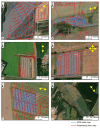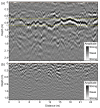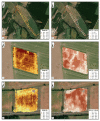Mapping of Agricultural Subsurface Drainage Systems Using a Frequency-Domain Ground Penetrating Radar and Evaluating Its Performance Using a Single-Frequency Multi-Receiver Electromagnetic Induction Instrument
- PMID: 32674514
- PMCID: PMC7412003
- DOI: 10.3390/s20143922
Mapping of Agricultural Subsurface Drainage Systems Using a Frequency-Domain Ground Penetrating Radar and Evaluating Its Performance Using a Single-Frequency Multi-Receiver Electromagnetic Induction Instrument
Abstract
Subsurface drainage systems are commonly used to remove surplus water from the soil profile of a poorly drained farmland. Traditional methods for drainage mapping involve the use of tile probes and trenching equipment that are time-consuming, labor-intensive, and invasive, thereby entailing an inherent risk of damaging the drainpipes. Effective and efficient methods are needed in order to map the buried drain lines: (1) to comprehend the processes of leaching and offsite release of nutrients and pesticides and (2) for the installation of a new set of drain lines between the old ones to enhance the soil water removal. Non-invasive geophysical soil sensors provide a potential alternative solution. Previous research has mainly showcased the use of time-domain ground penetrating radar, with variable success, depending on local soil and hydrological conditions and the central frequency of the specific equipment used. The objectives of this study were: (1) to test the use of a stepped-frequency continuous wave three-dimensional ground penetrating radar (3D-GPR) with a wide antenna array for subsurface drainage mapping and (2) to evaluate its performance with the use of a single-frequency multi-receiver electromagnetic induction (EMI) sensor in-combination. This sensor combination was evaluated on twelve different study sites with various soil types with textures ranging from sand to clay till. While the 3D-GPR showed a high success rate in finding the drainpipes at five sites (sandy, sandy loam, loamy sand, and organic topsoils), the results at the other seven sites were less successful due to the limited penetration depth of the 3D-GPR signal. The results suggest that the electrical conductivity estimates produced by the inversion of apparent electrical conductivity data measured by the EMI sensor could be a useful proxy for explaining the success achieved by the 3D-GPR in finding the drain lines.
Keywords: agricultural drainage systems; electromagnetic induction; frequency-domain; ground penetrating radar; inversion; non-destructive techniques; penetration depth.
Conflict of interest statement
The authors declare no conflict of interest.
Figures













References
-
- Koganti T., Van De Vijver E., Allred B.J., Greve M.H., Ringgaard J., Iversen B.V. Evaluating the Performance of a Frequency-Domain Ground Penetrating Radar and Multi-Receiver Electromagnetic Induction Sensor to Map Subsurface Drainage in Agricultural Areas; Proceedings of the 5th Global Workshop on Proximal Soil Sensing; Columbia, MO, USA. 28–31 May 2019; pp. 29–34.
-
- Skaggs R.W., Breve M.A., Gilliam J.W. Hydrologic and Water-Quality Impacts of Agricultural Drainage. Crit. Rev. Environ. Sci. Technol. 1994;24:1–32. doi: 10.1080/10643389409388459. - DOI
-
- Khand K., Kjaersgaard J., Hay C., Jia X.H. Estimating Impacts of Agricultural Subsurface Drainage on Evapotranspiration Using the Landsat Imagery-Based METRIC Model. Hydrology-Basel. 2017;4:49. doi: 10.3390/hydrology4040049. - DOI
-
- Fraser H., Fleming R., Eng P. Environmental benefits of tile drainage. LICO–Land Improvement Contractors of Ontario, Ridgetown College, University of Guelph; Ridgetown, ON, Cananda: 2001.
-
- Rogers M.B., Cassidy J.R., Dragila M.I. Ground-based magnetic surveys as a new technique to locate subsurface drainage pipes: A case study. Appl. Eng. Agric. 2005;21:421–426. doi: 10.13031/2013.18461. - DOI
Grants and funding
LinkOut - more resources
Full Text Sources
Other Literature Sources

